Mouse & Rat Poison Hazards
Poison is a popular method for killing rats and mice around homes, inside buildings, in attics and barns. However, utilizing poisons for rodent control comes with some hazards, poisoned animals often die in walls leading to terrible odors and expensive service calls. Secondary poisoning of other animals such as your pet, or area wildlife is also a risk. The Wildlife Whisperer knows how to get rid of rodents without the use of poisons.
Reasons To Avoid Using Rat Poison
We can tell you many horror stories about what we've seen come from the use of bar type rat poison and mouse poison bait stations. If you have seen what we have, you would no longer wish to hire a traditional pest control exterminator to set up bait stations or other rodenticide poisons.
Don't buy into the age-old pest control company myth that mouse and rat poison will dehydrate the rodent so it does not stink when it dies! If that was the truth, we would not have so many clients calling us from hotels asking us to locate the dozens of decaying rodent bodies inside their walls, attics, crawlspaces, basements and ceilings.
As soon as the first freeze or cold spell arrives, rodents and wildlife start moving indoors - that's the time of year when our poisoned animal calls drastically increase.
Individuals often use rat poison in an attempt to solve their raccoon, mouse, rat, skunk, mole, gopher and opossum problems. But when you use poison to control your wildlife problems, you may inadvertently kill cats, dogs, snakes, hawks, and even eagles. There are humane reasons not to use rodenticides, but there are practical ones as well, for instance, you may have to cut open your walls to remove dead animals.
A past client hired us to remove the exterior walls and ceiling of an attic in order to remove an entire family of dead raccoons - raccoons that died as a result of the homeowner's attempt at a do-it-yourself attic raccoon removal utilizing poisons. Notice the d-CON poisoned mouse shown in the photo just below, this one little creature alone created enough stench to force the homeowners to move out of their house and call us from their hotel room. Hotel fees, drywall repair, painting, deodorizing, dead pets ... how much does mouse poison really cost?
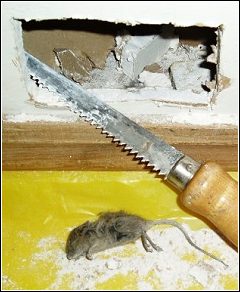
If you were going to die, where would you go? Would you go out on the front lawn so it would be easy for the morgue to pick you up? No, you'd want to go where you were most comfortable - in your own bed, with your spouse. So, where do you think that poisoned rodent will go to die? On the front lawn so you can easily scoop it up and place it in the trash can? The Wildlife Whisperer dead animal in wall removal experience will beg to disagree. We have the cool cameras to peek into walls and minimize damage when removing rotting bodies, but we'd rather not have to use them. And it's not just inside that dead animals can cause problems, they can also die under your home creating an expensive hassle once they have to be removed. It is still legal for many feed and hardware stores in the United States to sell strychnine for underground use on gophers.
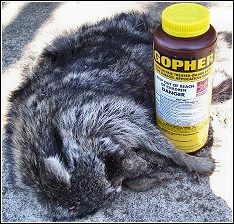
The raccoon pictured above was living under client's crawl space and concrete slab foundation. A feed store suggested they feed the raccoon strychnine wrapped in hamburger. The poison only cost $5.00. But in the end what was the real cost to take care of this client's wildlife problem? The flower beds had to be dug up to remove all of the dead poisoned bodies from under the concrete slab, the sub flooring and living room carpet also had to be removed in order to remove other, additional dead poisoned animals.
An hazard of using rat poison, such as the bait station seen below, is the possibility that yours or your neighbor's pet may accidentally get a hold of it. A situation seen over and over in veterinary emergency rooms.
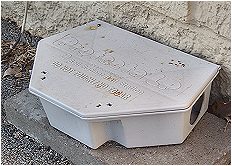
When animals eat rat poison, their feces can turn the color of the poison. The photo below shows a turquoise colored feces, which was the result of raccoons eating the Tomcat brand of rat poison bars. This particular feces belonged to the family of dead, poisoned raccoons we removed from a client's attic. If you see that your pet has produced an unusual color feces you may wish to seek medical attention for it right away.
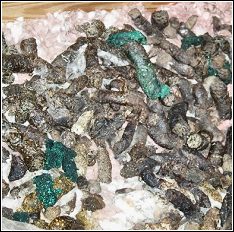
In most cases, when it comes to mouse or rat problem, you have two choices. One, fix the holes in your building so the rats and mice don't enter anymore - and be done with them once and for all, or two, utilize traps and poisons - and risk all of the problems that come along with it. Ask yourself ... which method is really the most cost effective one?
Secondary Poisoning
It is quite possible for pets to get into bait stations or access poison that's been set out to kill rodents. Even outside, animals such as cats and outdoor dogs can get into trouble. This isn't the only danger however, pets and wildlife can also die from eating other animals such as rats and mice that have recently eaten poison. This is known as secondary poisoning.

Homeowners often forget the fact that once the animal they have targeted has eaten poison, that animal itself now becomes poison for any other animals which may eat it.
In other words, if your pet eats a poisoned mouse they too will now have ingested the poison and may die - as victims of secondary poisoning.
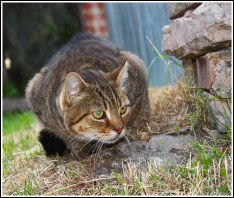
Each year countless pets, wildlife, even beautiful eagles and hawks die from secondary poisoning. You do not want to be responsible for the death of the wrong animal via secondary poisoning.
Annette King of Wild Heart Ranch, a non-profit wildlife rehabilitation clinic, is seen below holding "Spirit", an American Bald Eagle.
Spirit was a victim of secondary poisoning and never recovered, he looks good in the pictures below, but he was unable to recover from the poisoning and he died soon after these photos were taken.
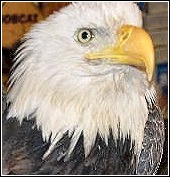
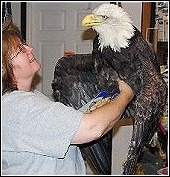
Annette King On The Hazards Of Secondary Poisoning
"Wildlife are typically discovered too late to benefit from medical treatment after ingesting rodent poison. We generally see a severely lethargic animal, often seizing or bleeding from the rectum, urethra or vomiting blood. Their gums will be pale, body temp failing and sooner or later, sometimes in feces or vomit or later in necropsy, the tell tale turquoise color of the poison will show up."
"Since every wild animal that is brought to us comes with a mystery to solve of "what happened?" and many conditions can cause the same symptoms, rodent poisoning is one of those conditions that if they come in with it and survive, we will never know. Of the cases that were diagnosed as rodent poisoning, 100% have been fatal. The problem with poisoning rodents is that it doesn't kill them fast enough. They wander aimlessly for hours before dying... easy prey for a hungry wild mammal or raptor. Secondary poisoning is just as serious, as the animal is too sick to hunt or fly, and will often starve to death. Secondary victims are the young, back at the den or nest that will starve to death or fall prey to predators as the providing parent will never return".
Dr. Michael Dix On Secondary Poisoning
Dr. Michael Dix, Medical Director, Best Friends Animal Society, has the following to say about secondary poisoning, "A dog or cat that eats the most commonly used rodent poisons will show signs related to an inability to clot their blood. These signs include, but are not limited to, unexplained bruising, bloody vomit or diarrhea, blood in the urine, and continuous bleeding from minor wounds. If these signs are noted, the animal should be taken to a vet right away (keeping in mind that other things can cause the same signs). A lot of rodenticides are a turquoise green color - so if this color is noted in your pet's stool, they should also go to a vet immediately even if they are not showing signs of not being able to clot their blood. The earlier it is known that there has been a poisoning with a rodenticide, the better the prognosis."
The Painful Truth About Poisons
Poisoning produces a slow painful death for any animal that is unfortunate enough to ingest it. Anti-coagulants contain chemicals that limit blood clotting and can take up to 2 weeks to kill the animal. Research with this poison type on humans proves that it is painful to bleed internally. Bromethalin can kill animals in just a few hours after a single helping and it attacks the central nervous system. Cholecalciferol is a vitamin D based poison that calcifies soft tissue on animals. Strychnine causes muscular convulsions and eventually kills the animal via sheer exhaustion. So, before you lay down a dish of anti-freeze for that nuisance skunk or cat to drink, please think twice. The Wildlife Whisperer, Inc. knows much better methods than poison for solving your rat and mouse problems.
-1242 SW Pine Island Rd., Suite 310
Cape Coral, Florida 33991-2126
help@totalwildlifecontrol.com














